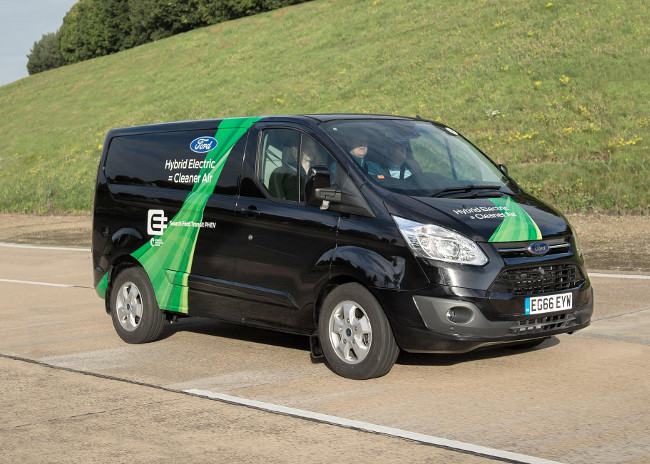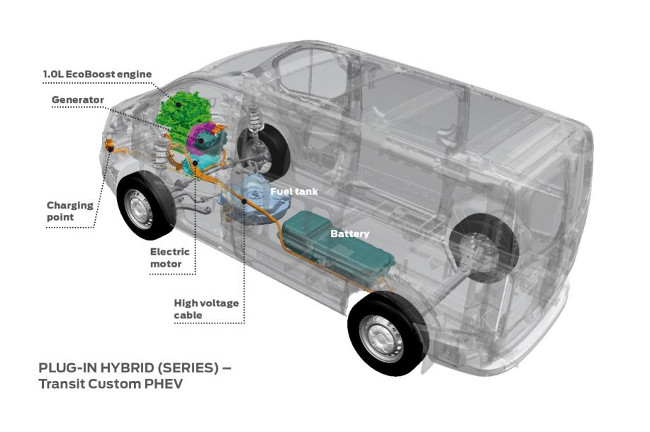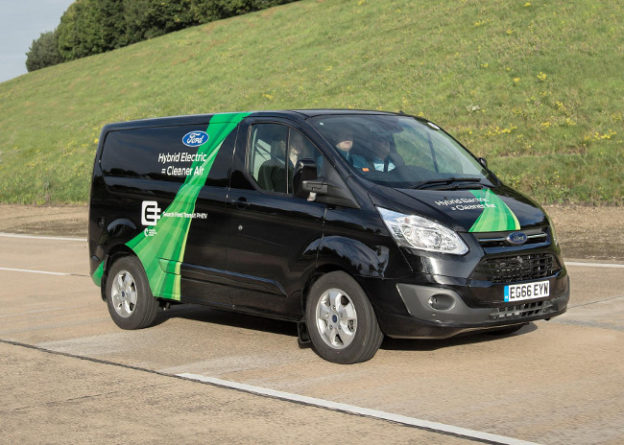
Ford’s planned Transit Custom plug-in hybrid van will go on trial in London later in 2017.
There’s a lot of talk about hybrids, plug-in hybrid electric vehicles (PHEV) and electric vans at the moment. But what does this actually mean?
Well, in simple terms, hybrids are vehicles with a petrol or diesel engine plus some form of electrical propulsion.
The most common type of hybrid uses an electric motor and a battery to provide electric assistance and perhaps electric-only operation at low speed. The battery is charged while driving and especially during braking.
The other type of hybrid is the range-extender electric vehicle. This is essentially an electric car or van with a petrol generator on board that’s used to charge the batteries if they run low while you’re driving.
What about PHEV? Oh yes. A Plug-in Hybrid Electric Vehicle can be either of the two types of hybrid I’ve described above, with one added extra. It also comes with a mains power socket so it can be plugged in to charge the battery when parked up.
What about the Transit hybrid van?
Ford has chosen to follow the range extender and PHEV routes with its upcoming Transit Custom PHEV hybrid.
This van isn’t planned for commercial production until 2019, but a fleet of 20 PHEV Transit will be undergoing a 12-month trial in London starting later this year.
As you may soon start seeing these low-emission vans on the road, I thought it would be interesting to take a look under the bonnet. I’ll aim to answer two important questions:
- How do these vehicles actually work?
- Why does using a petrol engine in this way make sense if you’re trying to cut emissions?
How does a range-extender hybrid work?
Ford has kindly provided an ‘x-ray’ picture of the new Transit PHEV which shows all the main systems used as part of the powertrain:

Battery, electric motor. charging point, engine and generator. Under the skin of the upcoming Transit Custom PHEV (source: Ford)
Here’s how the van will work. The battery pack is a liquid-cooled unit that’s fitted under the floor, so load capacity isn’t affected.
In urban environments, the goal will be to use electric power as much as possible. Ford says that a fully-charged battery should give the van a range of “in excess of 31 miles”.
Batteries can be charged by connecting the charging points to an electric charging point, but if this fails the van’s petrol engine will kick in and start charging the batteries. The van will continue to run as an electric vehicle, but with a supply of electricity from the engine-powered generator. (The generator itself is basically a large, high-powered alternator.)
All of this may seem complex, but it means that unlike with a pure electric vehicle, this hybrid can be driven unlimited distances without needing to be charged, simply filling up with petrol as usual.
Why is it better to use an engine in this way?
There are two reasons why a range extender PHEV should produce far lower emissions than any standard internal combustion engine vehicle.
The first reason is that if the van is used as it’s intended, it will run on battery power much of the time and will be charged from the mains when not in use. For urban use, it’s possible that the engine will rarely even be needed.
The second reason is that as you’ll probably have noticed, the engine fitted isn’t the usual 2.0-litre EcoBlue diesel that’s fitted to most Transit Custom vans. Instead, Ford will be fitting its popular 1.0-litre Ecoboost petrol engine, which is most commonly found in the Fiesta and Focus cars.
This engine produces fewer harmful emissions in general than the Transit diesel. But because it’s being used to power a generator, it can also be tuned to provide optimum efficiency when operating within a narrow rev range.
I’d expect this mode of operation to provide further reductions in emissions, when compared to a regular petrol or diesel-powered vehicle, which has to operate over a wide range of revs.


Pingback: Why van hire companies may soon need electric van fleets | vanrental.co.uk blog